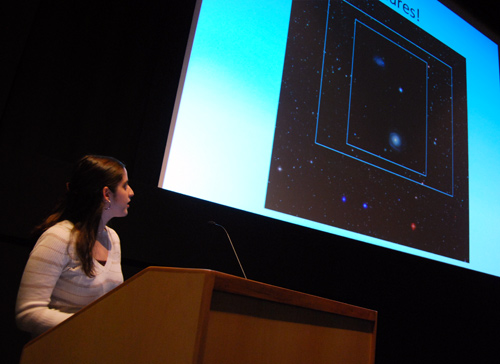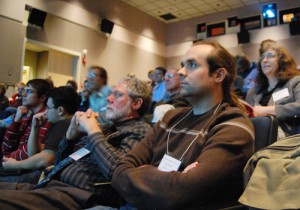Saturn’s Rings, Siberian Eclipse Topics at KECK Symposium

Astronomers interested in black holes generally study small, low-mass types within our own galaxy, or super-massive black holes found in the center of other large galaxies. But during the 18th Annual Undergraduate Research Symposium Nov. 7-8 at Wesleyan. astronomy major Hannah Sugarman ’09 explained the importance of finding intermediate mass black holes in the local universe.
“Small black holes are about 30 times the mass of the sun, and the big, super-massive black holes have a mass of about a million times the mass of the sun. Intermediate mass black holes are in between these mass limits,” Sugarman says. “They are important because if super-massive black holes are made by slightly smaller ones combining, we want to be able to observe the smaller ones to see how this works.”
Sugarman was among 70 students who attended the symposium, which was sponsored by the Keck Northeast Astronomy Consortium. Keck comprises astronomy faculty and students at eight small liberal arts colleges and universities in the northeast including Wesleyan, Colgate University, Middlebury College, Vassar College, Haverford College, Swarthmore College, Wellesley College and Williams College. Students and faculty also attended the symposium from Wheaton College in Wheaton, Illinois, Siena College in Loudonville, N.Y and the University of Rochester in Rochester, N.Y.
“Since astronomy programs at all of our institutions are fairly small, we always look forward to this annual event to be part of a larger, more scientifically and socially diverse group,” says William Herbst, the John Monroe Van Vleck Professor of Astronomy.

Originally funded by the W. M. Keck Foundation beginning in 1990, the Keck Northeast Astronomy Consortium is now supported by the National Science Foundation under their Research Experiences for Undergraduates (REU) program. Several of the student presenters conducted research through the REU program.
Student presenters spoke for 10-20 minutes on various topics from protoplanetary disk clearing to Saturn’s ringlet orbits.
Katie Judd and Amanda Curtis of Wellesley spoke on “Exploring Uncharted Territory: Using Cassini Data to Catalog Saturn’s B Ring Features;” Michael Petersen of Colgate spoke on Study of Star Formation Regions of Galaxies at Intermediate Redshifts;” Emma Wollman of Swarthmore spoke on “Spectral modeling of x-rays from hot star winds;” Katherine Dupré and Marcus Freeman of Williams spoke on “Coronal Observations During the Siberian Eclipse; and Jillian Garber of Middlebury spoke on “Dynamical Effects in Saturn’s Rings.”
Wesleyan student Marshall Johnson ’11 teamed up with Van Kaplan and Jacob Miller of Vassar to lead a discussion on “A Spectroscopic Study of the Structure of the Milky Way.
More than 25 faculty members attended the symposium, including Herbst, Joe Bruno, vice president for academic affairs and provost; Dana Casetti, visiting assistant professor of astronomy; Roy Kilgard, assistant astronomer; Ed Moran, director of the Van Vleck Observatory, chair of the Astronomy Department and associate professor of astronomy; Seth Redfield, assistant professor of astronomy.
Sugarman attended the symposium with her advisor, Ed Moran. She was impressed by the numerous symposium talks.
“It was cool seeing undergrads doing serious science work and understanding the complex issues behind their research at a very deep level,” she says. “I enjoyed being able to share the work that I have been doing with Ed Moran, and I thought it was a good experience to practice giving research talks like this.”
The symposium also included a tour of the Van Vleck Observatory, a reception and dinner in the Usdan University Center, a Star Party at the observatory featuring an observation through Wesleyan’s 20-inch Alvan Clark refractor, a viewing of the Feet to the Fire photography exhibit at the observatory, an ice-cream social and dance.

